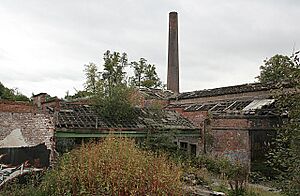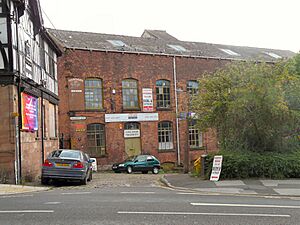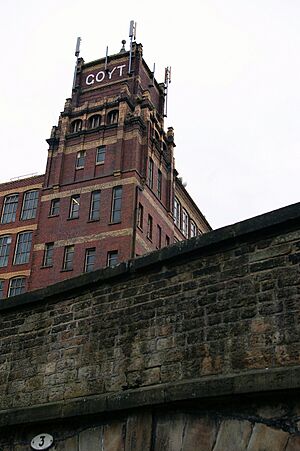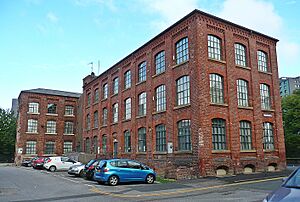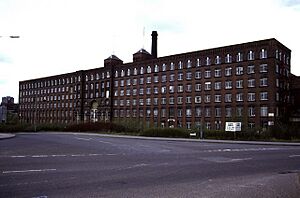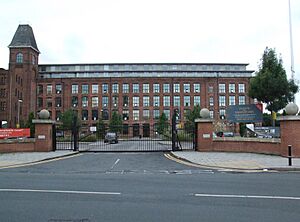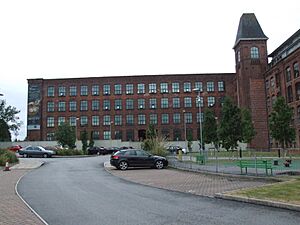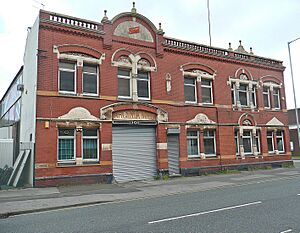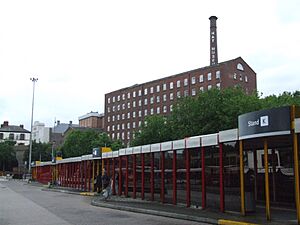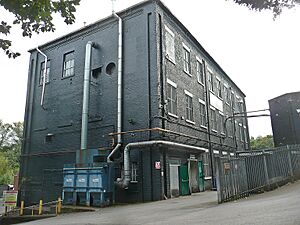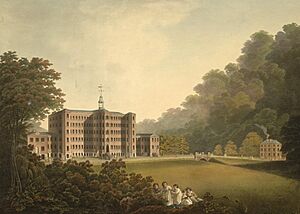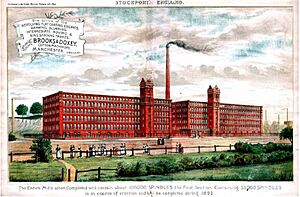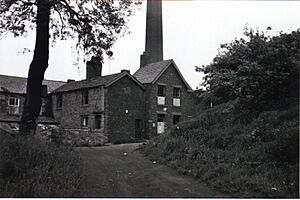List of mills in Stockport facts for kids
Stockport, a town in Greater Manchester, England, was once a very important place for making textiles. From the time of the Industrial Revolution until the 1900s, it was famous for spinning cotton and making hats. The valleys around the River Mersey and River Tame were filled with large brick factories. Many of these old buildings are still standing today, used as warehouses, homes, or shops. This article lists some of these historic mills.
Contents
- Mills Still Standing in Stockport
- Aqueduct Mill
- Brinksway Leather Works
- Brinksway Bank Mill
- Brinksway Mill
- Britannia Mill
- Broadstone Mill
- Cheadle (Bleach) Works
- Churchgate Mill
- Goyt Mill, Hawk Green, Marple
- Hallam Mill
- Houldsworth Mill
- Kingston Mill
- Lancashire Hill Ropery
- Lockside Mill
- Marriot Street Mill
- Meadow Mill
- Pear New Mill
- Reddish Spinning Co. Mills
- Reynolds Mill
- Spur Mill
- Unity Mills
- Vernon Mill
- Virginia Mills
- Wear Mill
- Welkin Mill
- Wellington Mill
- Wellington Works
- Other Mills in Stockport
- Albert Mill
- Albion Mill
- Beehive Mills
- California Mill
- Cataract Bridge Mill
- Coronation Mill
- Crow Park Mill
- Elder Mill
- Faulder's Mill
- Gorsey Bank Mill
- Hanover Mills
- Hollins Mill
- India Mill
- Logwood Mill
- Mellor Mill
- Orrell's Mill
- Palmer Mills
- Reddish Vale Printworks
- Rivett's Mill
- Springfield Mill
- Stockport Ring Mills
- Strines Print Works
- Wood Mill
Mills Still Standing in Stockport
Here are some of the textile factories in Stockport that you can still see today:
Aqueduct Mill
Located in Marple North, Aqueduct Mill is still standing.
Brinksway Leather Works
This mill is in Edgeley & Cheadle. It's a three-storey building with a sloped roof and a short, round brick chimney.
Brinksway Bank Mill
Also in Edgeley & Cheadle, this mill was a large three-storey factory with 50,000 spindles in 1872. Spindles are parts of machines that spin cotton. It was later owned by Samuel Moorhouse and then became part of a big company called the Fine Spinners and Doublers Association.
Brinksway Mill
Sometimes called Heaward's Mill, this factory is also in Edgeley & Cheadle. The first mill here, north of the River Mersey, was built around 1790. It had four storeys and a water tower. South of the river was another three-storey mill. In 1891, John and George Walthew owned this mill, along with Wellington and Springmount Mills, and had a huge 116,960 spindles. It later joined the Fine Spinners and Doublers Association.
Britannia Mill
Found in Reddish South, Britannia Mill was a weaving factory used from the 1870s to the 1930s. It made shirtings and towels, using between 100 and 200 looms (machines that weave fabric).
Broadstone Mill
Located in Reddish South, Broadstone Mill was originally a double mill with two chimneys. Only one part of the mill remains today. It was built in 1903.
Cheadle (Bleach) Works
This mill, also known as Cheadle Lower Mill, is in Cheadle & Gatley. The site has been used for bleaching (making fabric white) since the 12th century! It's now called The Bleachworks.
Churchgate Mill
You can find Churchgate Mill in Brinnington & Central. It was built by 1828. In the 1880s, it was used for spinning yarn for sewing and knitting. In 1891, Samuel Bunting and Co. had 16,000 spindles here.
Goyt Mill, Hawk Green, Marple
This large mill in Marple South was built in 1905. It has six storeys and a total floor area of 260,000 square feet. It used to have 82,000 mule spindles and 45,000 ring spindles for spinning cotton. A powerful steam engine provided its power, and coal was brought from nearby mines. Today, the mill is used for many different businesses.
Hallam Mill
Also known as Heaviley Mill, this mill in Davenport & Cale Green was owned by Ephraim Hallam in 1891. It used to be the Squirrel Sweet Works and is now home to a photo studio.
Houldsworth Mill
Located in Reddish North, Houldsworth Mill is a very important historic building, listed as Grade II*. This means it's a building of special architectural or historical interest. It was built in 1865.
Kingston Mill
You can find Kingston Mill in Edgeley & Cheadle. In 1891, Lucas Micholls and Co. had 33,460 spindles here.
Lancashire Hill Ropery
In Reddish South, this building was used by Reuben Rivett in the 1880s to make ropes. Later, it became the Lancashire Hill Rope & Twine Co Ltd. It is still standing.
Lockside Mill
This mill in Marple North was built in 1801 by Samuel Oldknow. It's a three-storey stone building right by the canal, and it used to have an internal canal arm for boats to load and unload goods.
Marriot Street Mill
Located in Brinnington & Central, this mill has now been turned into an apartment building.
Meadow Mill
In Brinnington & Central, Meadow Mill is a Grade II listed building. It was built around 1880 for T & J Leigh for spinning cotton and wool. By 1914, it had 120,000 spindles! It's made of two six-storey brick mills with a fancy engine house in between them.
Pear New Mill
Pear New Mill in Bredbury is another Grade II* listed building. It was one of the last cotton spinning mills built in the Edwardian era, starting production in 1913. It was known for its concrete floors and detailed design. It had 137,312 mule spindles. The mill stopped making textiles in 1978.
Reddish Spinning Co. Mills
These mills are in North Reddish.
- Victoria Mill (North mill): Built in 1870, this four-storey mill became part of the Fine Cotton Spinners and Doublers Association. It had 133,000 mule spindles by 1909. It's now marketed as apartments.
- Elisabeth Mill (Middle Mill): Also built in 1870, this four-storey mill was part of the same company and had the same number of spindles. It was powered by a 500 horsepower engine. It's also now apartments.
Reynolds Mill
Also known as Cromer Street Mill, this mill is in Brinnington & Central.
Spur Mill
In Reddish South, Spur Mill was a doubling mill built in 1907 with 20,000 spindles. It closed in 1972 but is still standing.
Unity Mills
Located in Woodley, Unity Mills is still standing.
Vernon Mill
Found in Portwood, Vernon Mill is a Grade II listed building. In 1891, the Vernon Cotton Spinning Co. had 150,000 spindles here.
Virginia Mills
This two-storey building on Hillgate in Manor was first recorded in 1872 and is still standing.
Wear Mill
Also known as Weir Mill, this mill in Edgeley & Cheadle is a Grade II listed building. In 1891, Thomas Fernley and Sons had 60,000 spindles here. It was built in 1884.
Welkin Mill
In Bredbury, Welkin Mill is a Grade II listed building.
Wellington Mill
Located on Wellington Road South, this mill is also a Grade II listed building. It was an early fireproof cotton spinning mill built in 1830–1831. In 1891, John and George Walthew had 116,960 spindles here. It became a hat factory in the 1890s and has been home to the Hat Works museum since 2000.
Wellington Works
Formerly known as Botany Mill, this mill in Woodley, Bredbury, is now Morrell's paint works.
Other Mills in Stockport
Many other mills existed in Stockport but are no longer standing or have been changed significantly.
Albert Mill
This four-storey mill in South Reddish was built in 1845 by Robert Hyde Greg. In 1911, it had 50,000 spindles.
Albion Mill
Located in Hazel Grove.
Beehive Mills
In Portwood, Beehive was a group of seven mills owned by T & J Leigh in 1872. One of these was Alligator Mill, a six-storey building used by the Alligator Rainwear Company until 1978. The site is now a Tesco supermarket.
California Mill
This two-storey brick mill in Stockport was used from 1858 to the 1890s for spinning waste cotton and making candlewicks.
Cataract Bridge Mill
Located in Mellor, this mill is currently redundant, meaning it's not in use, but there are plans to turn it into housing.
Coronation Mill
In Newtown Reddish, Coronation Mill was occupied by J&T Read in 1872. By 1900, it had 35,000 spindles.
Crow Park Mill
This fireproof brick mill in Portwood was built in 1833. It had six storeys and was designed to be strong and safe from fires.
Elder Mill
Located in Romiley, Elder Mill was powered by a 600 horsepower engine installed in 1937.
Faulder's Mill
Also known as Warren Street Mill, this mill was rebuilt after a fire in 1871. In the 1890s, it became a cocoa and chocolate factory. It was demolished in 1989.
Gorsey Bank Mill
In Higher Brinksway, this mill had two parts. The main mill had two storeys and five rows of cast-iron columns. It was powered by a 400 horsepower engine. In 1891, it had 12,000 spindles.
Hanover Mills
Built in Reddish in 1865 for cotton spinning, Hanover Mill was later changed in 1889 to make silk and velvet.
Hollins Mill
Located on Stockport Road in Marple, this mill was built in the early 1800s. It closed in 1954 and was demolished in 1957.
India Mill
In Heaton Mersey, India Mill was a combined mill. In 1891, it had 89,700 spindles and 1,800 looms.
Logwood Mill
This was a very early silk throwing mill, one of the first three in the UK, set up in 1732. It helped create a workforce used to factory work, which was important when cotton mills started in the 1780s.
Mellor Mill
In Marple, Mellor Mill was a huge six-storey mill built for Samuel Oldknow in 1793. It was used to spin coarse cotton. It was powered by water wheels, using water from the River Goyt and millponds. At its busiest in 1804, it had 10,080 spindles and employed about 550 people. Sadly, it was destroyed by fire in 1892.
Orrell's Mill
Also known as Travis Brook Mill, this mill in Heaton Norris was very important historically. It was one of the first to use cast-iron I-beams in its construction, making it stronger and more fire-resistant. Built in 1834, it was designed to hold many thousands of spindles and looms. It was damaged by fire in the 1960s and later demolished.
Palmer Mills
In Portwood, Palmer Mills had 167,000 spindles in 1891.
Reddish Vale Printworks
This printworks in Reddish Vale started before 1800. It was used for printing patterns on fabric. It was originally powered by water from the River Tame.
Rivett's Mill
Also known as Lancashire Hill Mill, this mill in Heaton Norris was owned by Joseph Rivett & Sons. It had an octagonal brick chimney and a three-storey building.
Springfield Mill
In Longshut Lane, this single-storey mill was weaving towelling on 260 looms in 1897.
Stockport Ring Mills
These three mills in Heaton Norris ran 200,000 spindles between 1892 and 1911. They were large brick buildings with engine houses and chimneys.
Strines Print Works
Located in Strines, Marple, this print works was acquired by the Calico Printers' Association in 1899.
Wood Mill
In Woodley, Stockport, Wood Mill was demolished in 1964.
|



